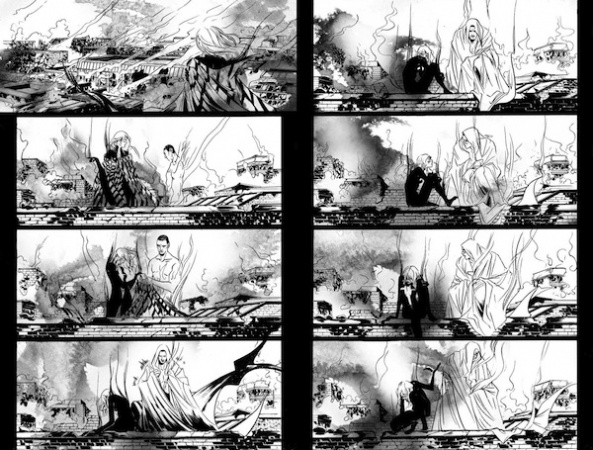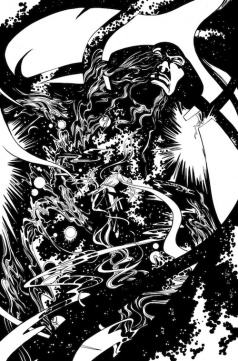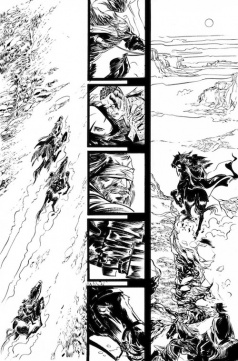
As part of our continuing Artist August series, today features another in-depth interview about process and work from one of our favorite artists in the business today. But today is a little bit different. Today’s not just about Artist August, although that’s definitely a big part of it.
Today we’re also going to be going bananas for a book called “Pretty Deadly.”
We’ll have different looks at the upcoming Image series all day, and to kick it off, we are extremely excited to present a chat with the artist and co-creator of the book, the extremely talented Emma Rios. Read on as we talk about architecture, Westerns and more for our first Artist August feature of the day.
Emma, why comics?
Emma Rios: It wasn’t a conscious decision to me, being a reader since I can’t remember. But there are three things in my opinion that make comics a perfect choice: it is a thing you can do on your own, that it’s fairly cheap and it allows you to tell and show anything. The sequential art is the most powerful medium of expression out there to me.
What was your first experience with comics as a reader?
ER: I learnt how to read by reading comics so there is no way I can remember that. I could tell you one or two stupid anecdotes though. When I was a kid, eating was so boring to me and the only way my parents managed to make me survive was by reading at the same time. I inherited all the Asterix collection from them, among other things, and still keep it, with all the food stains in the pages. It’s gross, I know.
When did you know that comics were a thing that you wanted to do for a living?
ER: Not very early actually. In Spain the industry is still small, and it doesn’t allow an artist to live only from comics money. In my case, despite creating comics since I was 14, I never considered that I was going to make it, professionally speaking, beyond the small press. I studied architecture and always thought I was going earn my rent money from that and make comics just for fun. It wasn’t until I found out that my stuff could be interesting for foreign markets that I realized there could be a chance. I was around 26 or so.
Where does your background in illustration come from?
ER: I’m self taught. I started drawing as a kid, like most kids, but in my case I just didn’t stop since then.
Architecture probably gave me some tools and understanding about space and composition, and maybe some taste. Also when I break a wall in my comics I know what is in the middle, you know? It’s a pretty useful background.

Obviously (to me, at least) your layouts are some of the more interesting pages out there, but in what ways do you apply your lessons in architecture to the sequential art form?
ER: When I was designing my architecture projects I was always thinking about how people were going to interact there. In comics when I draw the characters I’m always thinking about the space they are interacting with.
Besides the background architecture gives you, in order to try to understand how things work, break or have to be designed to be reasonable, it also gives you a vision about space that can be transmitted at different scales in comics: from layouts, to rhythm, to composition. It´s something I try to think about.
Can you talk a bit about your general process when it comes to composing a new page?
ER: My process is basically instinct. Luckily most comic artists have our own subconscious database carved by fire in our brains after reading a lot; that’s what make things work for us. It’s not that there is a magic formula for inspiration. For me it´s all learning by trying to understand the things I dig.
I always struggle about composition. It’s somehow easy for me to work with weird shapes but following that, or testing formal stuff without a reason all the time, can be distracting and make the reading suffer a lot. So, I always try to restrain myself and use those resources to emphasize things that really need to be remarked.
Continued belowI’m trying not to think much about shape and more about rhythm. What worries me is when to add a close shot, a detail, a general view… make things dynamic, from action to talking heads.
Also I believe each project demands different things. Lately, in “Pretty Deadly” for example, I tend to work a lot with drastic changes from wide horizontal panels to extra close detail shots, to recall that Western mood everybody loves. In “Captain Marvel” instead I remember working very vertical because of Carol’s attachment to flying, etc.
One of your earliest works in comics (that I’m aware of from my own collection) was “Hexed” over at BOOM! Studios. How did this collaboration with Michael Nelson and BOOM! originally come about?
ER: I was damn lucky.
Even if I was not working professional I’d been pretty much into fanzines and small press in Spain, and had some stuff posted on the Internet by the time BOOM! got aware of my stuff.
I remember adding Warren Ellis as a contact in flickr to follow his stuff there. A day after, he posted about my work on his website and, suddenly, my work was visible outside Spain. A month later, Matt Gagnon from BOOM! wrote me directly offering a full mini, just after taking a glimpse to my blog. That mini was “Hexed.”
I know Ellis is always helping a lot of people entering the business that way. Indirectly, I definitively owe him my career. If things go well, I’d love to return the favor, having the chance of doing something like that for somebody else in the future.

You’ve done quite a lot of work at Marvel now, from “Osborn” to “Strange” and beyond. How did you originally come to work at Marvel Comics?
ER: I got to meet Alejandro Arbona, former editor at Marvel, in Barcelona’s convention in 2008 and he really liked my stuff back then. But even if you receive compliments in these kind of interviews, it is very difficult to find the right moment, the right book, the right writer… it’s totally a matter of luck. Especially without any real professional background.
But, it is the way to do it. I really think it’s important to move forward on you own and commit your rightful own mistakes. But once you have something done I also encourage people to show their stuff, receive feedback and try to learn from it. I improved a lot thanks to that.
After getting “Hexed” I also met CB Cebulski in Aviles, another spanish convention several months later. He liked my stuff a lot too. BOOM! Studios promoted Hexed a lot, and we had a really nice response from critics, so I imagine it was just right timing. Before finishing “Hexed,” Cebulski offered me a short fill in in “Runaways” in which I worked with James Asmus.
But it was Mark Waid who really put me in the business asking for me to collaborate with him in “Strange: the Doctor is Out.” He really pushed my career, trusting me for that job after “Hexed.” Everything went pretty fast since then thanks to other people, like for example Steve Wacker.
I don’t know many experiences from other creators in the business, but mine was all about people trusting me and giving me chances.
So lets talk about your upcoming creator-owned work with Kelly Sue, “Pretty Deadly.” In talking with Kelly Sue she says that it was you that suggested the Western angle. What is it about Westerns that you find fascinating?
ER: Western is such a wild and pure genre.

From Ford’s hope,to Leone’s lost of it and careful aesthetics, to Peckinpah’s dusty cruelty… you just could define Western by three concepts: loneliness, languid pacing and explosions of violence.
An atmosphere between the ugly and the sublime…
Atmosphere is my favorite word in comics, I repeat it all the time.
In environments as tough, drawing alone is not enough. You have to handle carefully the rhythm through the layouts, guide the eye of reader to those not-that-necessary details in the background, try to show how the air flows, the dust blinds, and more than anything develop the characters from the inside more than ever, because nobody talks much and it has to be all mood.
Continued belowWhat comic creator in the world wouldn’t be seduced by such a challenge?
With working with Kelly for Marvel and now working on your own book together, is there anything inherently different about the collaborative relationship?
ER: On one hand we have more time and freedom to enjoy struggling, on the other we are building something new which, moreover, ended up becoming more weird than expected. So, yep, feels different.
We are on our own in a setting that is all that freedom. I’m totally under that impression that the book is dragging us while growing by itself. We are building it almost page by page, and it’s working as hell in a process full of insecurities that is touching and fun.
This is our thing, and feels incredibly important.
It’s frightening as hell but I wouldn’t change it for the world.
On that same thread, for you, is there anything different about how you approach the page on a book like “Pretty Deadly” versus a work for hire book?
ER: No. I always treat wfh as if it were my own, don’t know how to work otherwise.
That said, each project demands its own storytelling so, even if I have recurrent tricks, they all have differences.

I’ve seen a small sample of the book, but in terms of the design and the landscape of the title what are you pulling from for influences? I must say, the book looks incredibly lush with its setting.
ER: Movies, a lot. I´ve been watching and re-watching almost a Western per day for months. Also old samurai stuff, that to me is like dope.
Comics, quite a lot too. From the Golden Age anthology by Steven Brower, Tex, Mora and de La Fuente’s Sunday, to The Bouncer or Blueberry, to terrific recent stuff like GUS by Blain which is probably my favorite Western comic ever.
The book is not a regular western though. It plays with common elements but also feels like a dark fantasy oniric thing, and I´m trying to adapt the pacing to that too.
There are two Japanese creators that are literally eating all my neurons now, one is Taiyou Matsumoto and the other one Daisuke Igarashi. They do magic, handling all those things I told you I cared about, when it comes to atmospheric stuff.

How did you come about designing the lead character, Ginny? Were there any models you looked towards, or anything specific for her facial tattoos? (Those are tattoos, correct?)
ER: The skull face was Kelly Sue’s idea. When she mentioned that, the first image in my head was Fever Ray Karin’s makeup, but I ended up making it more and more minimal to preserve the factions and the humanity, because I kinda like working with very subtle expression emotions . That’s why it ended up turning into tattooed lines.
When I drew her for the first time I was testing some androgynous Lee van Cleef, with shorter hair. Then we talked a lot about the hair, if it would be better a bit longer, wilder, then we talked about functionality, about being dirty, and being fighting… I ended up doing some sketches trying to make her believable under a gunslinger overall outfit or a dress. It worked, I think.
With creating and working on “Pretty Deadly,” what particular itch do you find the book scratches for you?
ER: Create a world, probably.
I know you’d worked with her before on the wonderful Doctor Strange graphic novel, but how did you end up deciding to ask Jordie Bellaire to join the “Pretty Deadly” party? What is it about Jordie’s colors that you enjoy most when added to your line art?
ER: This is the third project we share together, and each time she is coloring my line differently. Besides the obvious things like taste and palettes… what I love from Jordie is that she is not conformist at all, that besides the artist the book has weight on her decisions of approaching the work.
Also she cares for narration the most, using the color as a narrative tool is essential in comics. Her work always clarifies a lot. She is damn good.
Continued belowSo with the creative team you’ve assembled for Pretty Deadly, it seems like you guys are pretty much ready to take over the world. Are you excited to get this book out there? Nervous? A mix of both? The reaction so far seems pretty universally positive/excited.
ER: I didn’t expect such hype! It’s all Kelly Sue’s fault… because it’s impossible not to love her. She is my sister Kraken so I kinda understand.
We are actually freaking out a bit but also immensely flattered and happy, and really appreciate all this incredible support. And I swear we are trying hard as hell to fulfill all those expectations.
We are so so fortunate.

Looking back to where you started as an artist and where you are in terms of the body of work done and that you’re about to start a new creator-owned series, are you satisfied with the career arc you’re currently on? Is there anything you still want to make sure you do in comics?
ER: Yep, I’m satisfied. I believe that moving to creator owned stuff is a step forward to me, learn how things work when you are on your own… after all I come from self publishing and small press and working at Image feels comfortable and exciting. Like starting again. I’m so glad to have reached this point now, just hope to hold up fine.
And yep, there is something I still want to do which is writing and drawing my own stuff from time to time. I’m on it.
Do you have any other future plans for books you’d like to work on, or is Pretty Deadly pretty much the plan right now?
ER: Pretty Deadly is basically The Plan, we want to do more arcs and spend some time in this world. Also, I’m working at the same time on something else on my own but it’s still a bit soon to talk about it.
Generally speaking, are there any artists whose work you particularly draw from as an influence — both in Pretty Deadly and outside of this, in your work in general.
ER: American classics like Wally Wood, Al Williamson, Buscema or Gene Colan, also Shirato Sanpei, Otomo or Samura, Bernet, de la Fuente, Crepax…
Some people in animation influenced me a lot as well, Satoshi Kon for example or genius background designer Hiromasa Ogura. And from video games like Yoji Shinkawa or Akihiko Yoshida.
Are there any artists out there today whose work you particularly enjoy?
Anything that comes from Igarashi or Matsumoto, my friend Jose Domingo whose book Adventures of a Japanese Businessman has just been released by Nobrow, Brandon Graham, Milonogiannis, my dear sister Hwei Lin Lim, Angie Wang, Marcos Martín, Javi Rodríguez, Emily Carrol, Natsume Ono, Samnee, Pulido, Guy Davis, Marian Churchland, Frank Quietly, Blain, Pope, Est Em, Ken Niimura, Paul Maybury, Tomer Hanuka, Sam Hiti, Gipi… and a ton more.
I have a tumblr about influences and inspirational stuff, my kind of scum: http://steinerfrommars.tumblr.com/
Last question: would you rather be stuck in a city floating in the sky and try to find your way back down to Earth, or would you rather be stuck in a city on the ocean floor trying to find your way back to the surface?
ER: I’d rather evolve and being able to breath under the water and out of the atmosphere.






